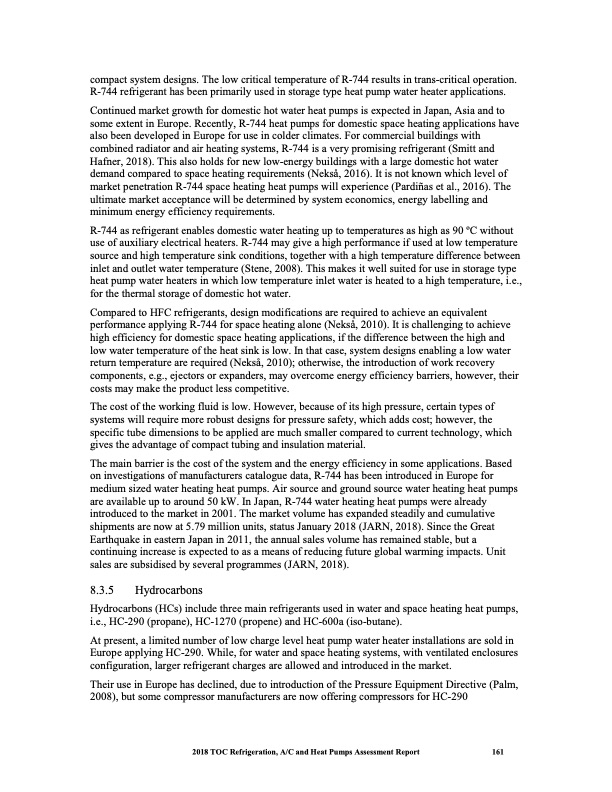
PDF Publication Title:
Text from PDF Page: 174
compact system designs. The low critical temperature of R-744 results in trans-critical operation. R-744 refrigerant has been primarily used in storage type heat pump water heater applications. Continued market growth for domestic hot water heat pumps is expected in Japan, Asia and to some extent in Europe. Recently, R-744 heat pumps for domestic space heating applications have also been developed in Europe for use in colder climates. For commercial buildings with combined radiator and air heating systems, R-744 is a very promising refrigerant (Smitt and Hafner, 2018). This also holds for new low-energy buildings with a large domestic hot water demand compared to space heating requirements (Nekså, 2016). It is not known which level of market penetration R-744 space heating heat pumps will experience (Pardiñas et al., 2016). The ultimate market acceptance will be determined by system economics, energy labelling and minimum energy efficiency requirements. R-744 as refrigerant enables domestic water heating up to temperatures as high as 90 oC without use of auxiliary electrical heaters. R-744 may give a high performance if used at low temperature source and high temperature sink conditions, together with a high temperature difference between inlet and outlet water temperature (Stene, 2008). This makes it well suited for use in storage type heat pump water heaters in which low temperature inlet water is heated to a high temperature, i.e., for the thermal storage of domestic hot water. Compared to HFC refrigerants, design modifications are required to achieve an equivalent performance applying R-744 for space heating alone (Nekså, 2010). It is challenging to achieve high efficiency for domestic space heating applications, if the difference between the high and low water temperature of the heat sink is low. In that case, system designs enabling a low water return temperature are required (Nekså, 2010); otherwise, the introduction of work recovery components, e.g., ejectors or expanders, may overcome energy efficiency barriers, however, their costs may make the product less competitive. The cost of the working fluid is low. However, because of its high pressure, certain types of systems will require more robust designs for pressure safety, which adds cost; however, the specific tube dimensions to be applied are much smaller compared to current technology, which gives the advantage of compact tubing and insulation material. The main barrier is the cost of the system and the energy efficiency in some applications. Based on investigations of manufacturers catalogue data, R-744 has been introduced in Europe for medium sized water heating heat pumps. Air source and ground source water heating heat pumps are available up to around 50 kW. In Japan, R-744 water heating heat pumps were already introduced to the market in 2001. The market volume has expanded steadily and cumulative shipments are now at 5.79 million units, status January 2018 (JARN, 2018). Since the Great Earthquake in eastern Japan in 2011, the annual sales volume has remained stable, but a continuing increase is expected to as a means of reducing future global warming impacts. Unit sales are subsidised by several programmes (JARN, 2018). 8.3.5 Hydrocarbons Hydrocarbons (HCs) include three main refrigerants used in water and space heating heat pumps, i.e., HC-290 (propane), HC-1270 (propene) and HC-600a (iso-butane). At present, a limited number of low charge level heat pump water heater installations are sold in Europe applying HC-290. While, for water and space heating systems, with ventilated enclosures configuration, larger refrigerant charges are allowed and introduced in the market. Their use in Europe has declined, due to introduction of the Pressure Equipment Directive (Palm, 2008), but some compressor manufacturers are now offering compressors for HC-290 2018 TOC Refrigeration, A/C and Heat Pumps Assessment Report 161PDF Image | Heat Pumps Technical Options

PDF Search Title:
Heat Pumps Technical OptionsOriginal File Name Searched:
RTOC-assessment-report-2018_0.pdfDIY PDF Search: Google It | Yahoo | Bing
CO2 Organic Rankine Cycle Experimenter Platform The supercritical CO2 phase change system is both a heat pump and organic rankine cycle which can be used for those purposes and as a supercritical extractor for advanced subcritical and supercritical extraction technology. Uses include producing nanoparticles, precious metal CO2 extraction, lithium battery recycling, and other applications... More Info
Heat Pumps CO2 ORC Heat Pump System Platform More Info
| CONTACT TEL: 608-238-6001 Email: greg@infinityturbine.com | RSS | AMP |